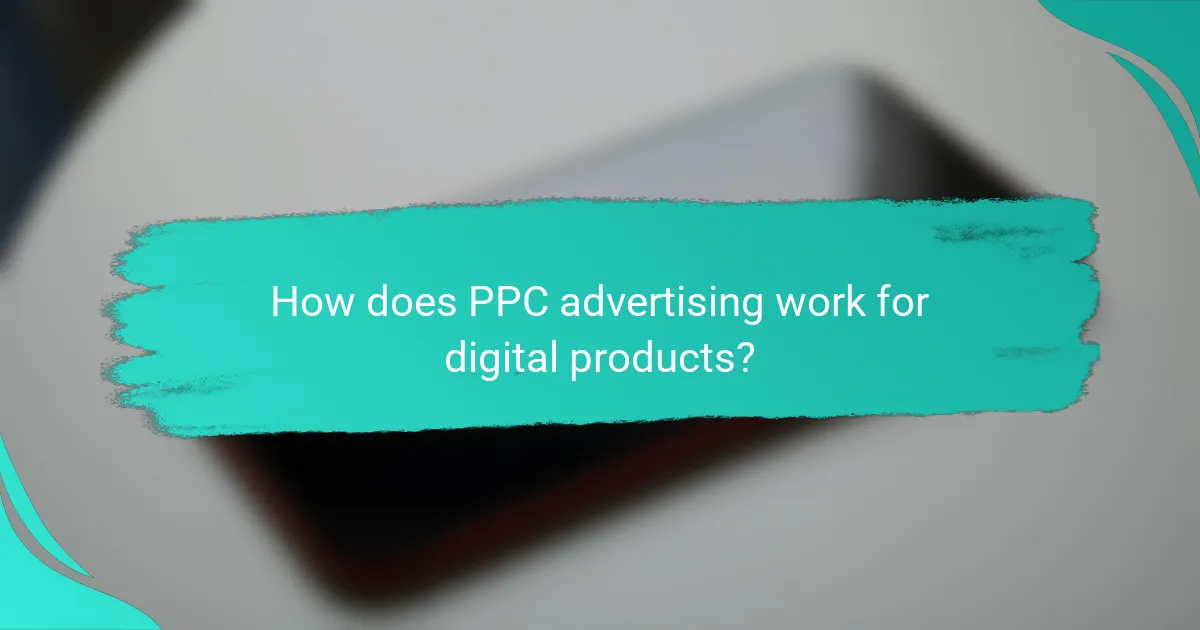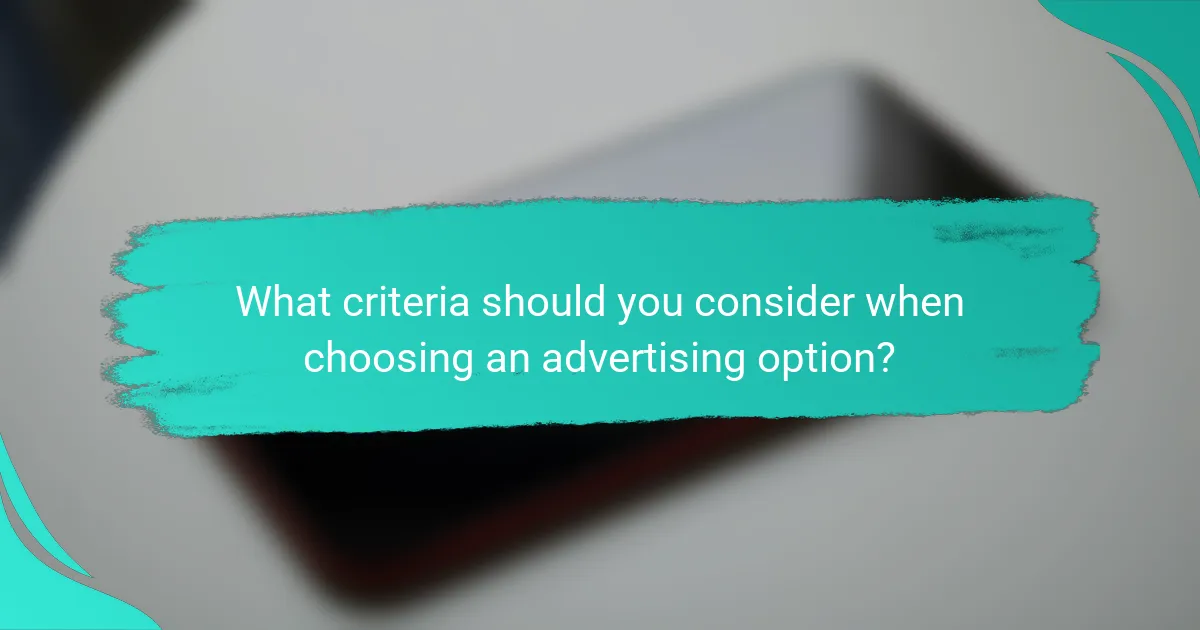Paid advertising options such as PPC, social media ads, and retargeting campaigns are essential tools for promoting digital products. Each approach offers distinct benefits, enabling businesses to effectively reach their target audience and drive conversions. By leveraging these strategies, advertisers can enhance their visibility and engagement in a competitive digital landscape.

What are the best paid advertising options for digital products?
The best paid advertising options for digital products include PPC advertising, social media ads, and retargeting campaigns. Each method has unique advantages and can effectively drive traffic and conversions when used strategically.
PPC advertising
PPC, or pay-per-click advertising, allows businesses to bid on keywords to display ads in search engine results. Advertisers only pay when a user clicks on their ad, making it a cost-effective way to gain visibility for digital products.
Key considerations for PPC include selecting relevant keywords, setting a budget, and optimizing ad copy for higher click-through rates. It’s essential to monitor campaign performance and adjust bids and targeting as needed to maximize return on investment.
Social media ads
Social media ads leverage platforms like Facebook, Instagram, and LinkedIn to reach targeted audiences based on demographics, interests, and behaviors. These ads can take various formats, including images, videos, and carousel ads, allowing for creative engagement.
When creating social media ads, focus on crafting compelling visuals and clear calls to action. Testing different ad formats and targeting options can help identify what resonates best with your audience, enhancing overall campaign effectiveness.
Retargeting campaigns
Retargeting campaigns aim to re-engage users who have previously interacted with your digital products but did not convert. By displaying ads to these users across various platforms, you can remind them of your offerings and encourage them to return.
To implement effective retargeting, segment your audience based on their behavior, such as website visits or abandoned carts. Use tailored messaging to address their specific interests and provide incentives, like discounts, to encourage conversions. Regularly analyze campaign performance to refine your approach and improve results.

How does PPC advertising work for digital products?
PPC advertising, or pay-per-click advertising, allows businesses to promote their digital products by paying for clicks on their ads. This model enables advertisers to reach potential customers actively searching for related products, making it a targeted and efficient marketing strategy.
Keyword targeting
Keyword targeting is the process of selecting specific words or phrases that potential customers are likely to use when searching for digital products. By choosing relevant keywords, advertisers can ensure their ads appear in search results when users express interest in those products.
To effectively target keywords, conduct thorough research using tools like Google Keyword Planner or SEMrush. Focus on a mix of high-volume and long-tail keywords to capture both broad and niche audiences. Regularly review and adjust your keyword list based on performance metrics.
Cost-per-click model
The cost-per-click (CPC) model means advertisers pay a fee each time someone clicks on their ad. This pricing structure allows businesses to control their advertising budget while only paying for actual engagement with their ads.
CPC rates can vary significantly based on competition, industry, and keyword selection. Generally, costs can range from a few cents to several dollars per click. To optimize spending, set a clear budget, monitor performance, and adjust bids for keywords based on their effectiveness in driving conversions.

What are the benefits of social media ads?
Social media ads offer businesses a powerful way to reach their target audience effectively and efficiently. They provide opportunities for precise targeting, enhanced engagement, and increased brand visibility.
Targeted audience reach
Social media platforms allow advertisers to target specific demographics, interests, and behaviors, ensuring that ads reach the most relevant users. For instance, businesses can focus on age groups, geographic locations, and even online behaviors to tailor their campaigns.
This targeted approach can lead to higher conversion rates, as ads are shown to users who are more likely to be interested in the product or service. Advertisers should regularly analyze their audience data to refine targeting strategies and maximize ad effectiveness.
Engagement and brand awareness
Social media ads are designed to foster interaction, making them an effective tool for boosting engagement and brand awareness. Engaging content, such as videos or interactive polls, can encourage users to like, share, or comment, amplifying the ad’s reach.
Additionally, consistent exposure through social ads helps build brand recognition. Businesses should consider using eye-catching visuals and clear calls to action to enhance user interaction and create memorable impressions.

How can retargeting improve conversion rates?
Retargeting can significantly enhance conversion rates by re-engaging users who have previously interacted with your brand but did not complete a desired action, such as making a purchase. By serving targeted ads to these potential customers, businesses can remind them of their interest and encourage them to return and finalize their transactions.
Re-engagement of potential customers
Retargeting focuses on users who have shown interest in your products or services but left without converting. This strategy keeps your brand top-of-mind, increasing the likelihood that these individuals will return to your site. For example, if a user visits an online store and views a specific product, retargeting ads can remind them of that product across various platforms.
To maximize re-engagement, consider segmenting your audience based on their behavior. For instance, users who added items to their cart but did not purchase can receive different ads compared to those who merely browsed. This tailored approach can lead to higher conversion rates.
Personalized ad experiences
Personalization is a key element of effective retargeting. By leveraging data from previous interactions, businesses can create ads that resonate with individual users. For example, showing an ad featuring a product a user viewed, along with a special discount, can entice them to return and complete their purchase.
Implementing dynamic ads that automatically update based on user behavior can enhance the personalization experience. This means that if a user browsed multiple items, the retargeting ads can showcase those specific products, making the ads more relevant and increasing the chances of conversion.

What are the costs associated with paid advertising?
Paid advertising costs can vary significantly based on the platform, targeting options, and overall strategy. Understanding these costs is crucial for budgeting effectively and maximizing return on investment.
PPC budget considerations
Pay-per-click (PPC) advertising typically involves setting a daily or monthly budget that dictates how much you are willing to spend on ads. Bids can range from a few cents to several dollars per click, depending on the competitiveness of the keywords you choose.
To optimize your PPC budget, consider using tools to analyze keyword performance and adjust bids accordingly. It’s advisable to start with a moderate budget and gradually increase it based on the campaign’s performance metrics, such as click-through rates and conversion rates.
Social media ad pricing
Social media advertising costs can vary widely based on the platform and ad format. For instance, Facebook and Instagram ads may charge on a cost-per-click (CPC) or cost-per-impression (CPM) basis, with average CPC rates often falling between $0.50 and $3.00.
When planning your social media ad budget, consider factors such as audience targeting, ad placement, and the duration of the campaign. Testing different ad creatives and formats can help identify what resonates best with your audience, allowing for more effective spending.

What criteria should you consider when choosing an advertising option?
When selecting an advertising option, consider your target audience, marketing goals, and budget. Each option, whether PPC, social ads, or retargeting, has unique strengths that align differently with these criteria.
Target audience demographics
Understanding your target audience demographics is crucial for effective advertising. Different platforms attract various user groups; for instance, Facebook tends to have a broader age range, while platforms like TikTok are popular among younger users.
Analyze your audience’s age, gender, location, and interests to choose the right advertising option. Tools like Google Analytics can help you gather insights about your audience, ensuring your ads reach the right people.
Marketing goals alignment
Your marketing goals should guide your choice of advertising options. If your aim is immediate sales, PPC might be the best fit due to its quick results. In contrast, if brand awareness is your priority, social ads can effectively reach a larger audience over time.
Consider how each advertising method aligns with your specific objectives. For example, retargeting is effective for nurturing leads who have previously interacted with your brand, making it suitable for conversion-focused campaigns.
